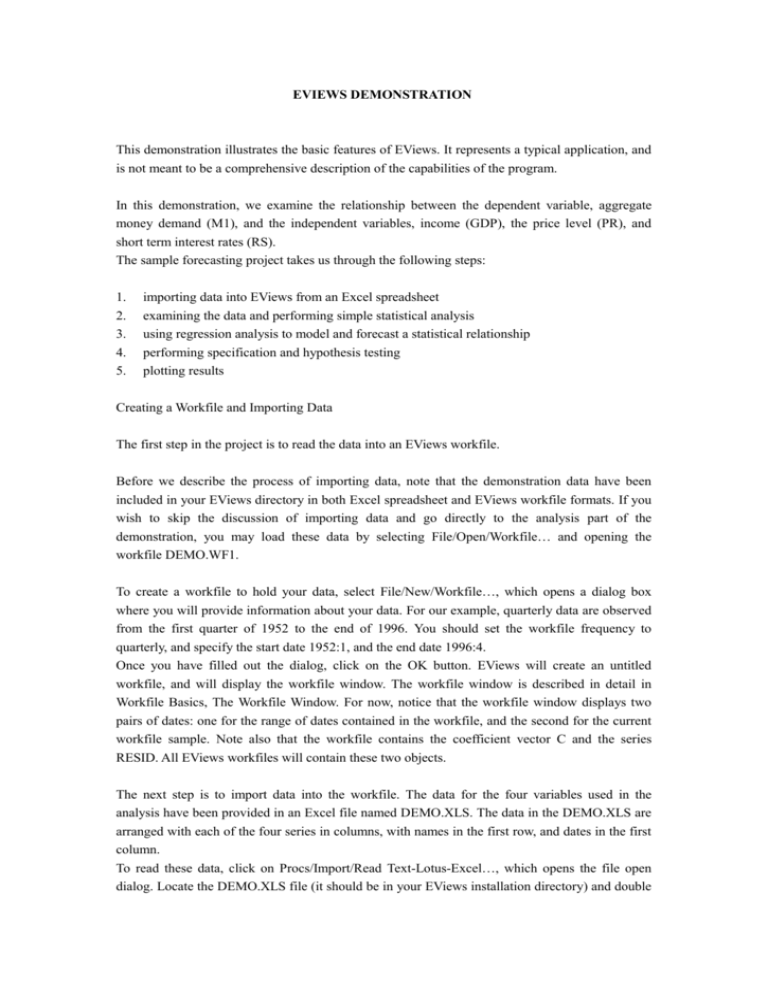
To obtain this view we open the group and then select View/Descriptive Stats/Common Sample. Another useful view is the Descriptive Stats view that gives summary statistics that can be checked against those that appear in the lower panel of Table 5.1. The list of observations that we checked against Table 5.1 is one type of information it is called the spreadsheet view of the group. One of the advantages of creating a group of variables is that we can view a variety of information on the collection of variables in that group. In line with the text, we call it table5 1. The last 3 observations can be checked by scrolling down.īy selecting Name we can name the group object in the following window. Note that the first 5 observations are the same as those in Table 5.1 on page 109 of the text.
#How to forecast in eviews series#
In the following window that appears, we type the names of the series to be included in the group, and then click OK. We have left Name for object as Untitled. At present we select Group as the relevant object, and then click OK. Only the top few are displayed in the above screen shot. We will encounter many of these objects (but not all of them) as we proceed through the book. To see a list of possible objects, select Object/New Object from the workfile toolbar.Ī long list of possible objects appears. As Richard Startz says in EViews Illustrated, “object is a computer science buzz word meaning ‘thingie’.” Several chapters of the Startz book can be found under Help. The concept of an object is a bit vague, but you can think of it as anything that gets stored in your workfile. This new way is more cumbersome, but it will help you understand the more general concept of an object and how objects are created.Ī group is one of many types of objects that can be created by EViews. To extend your knowledge of EViews, we now describe another way. In Chapters 1 and 2 we created a group by (1) highlighting the series to be included in the group, (2) double clicking the highlighted area, and (3) selecting Open Group.

We will create a group and then check the data and summary statistics to make sure they match those in Table 5.1 on page 109 of the text. The data on each of the variables SALES., PRICE and ADVERT can be examined one at a time or as a group, as described in Chapters 1 and 2.

After choosing the name Andys_Burgers, your workfile will appear as However, if working with an untitled page is disconcerting for you, you can give it a name by selecting from your workfile toolbar Proc/Rename Current PageĪ window appears in which you can name the page. We will rarely use this option because most problems can fit neatly within the one page. It is possible to use a number of “pages” within the same EViews file.

The other objects C and RESID appear automatically in all EViews workfiles. And note the location of the data series in the workfile. Note that the range and sample are set at 75 observations. Opening this file as described in Chapters 1 and 2 yields the following screen Observations on SALES, PRICE and ADVERT for 75 cities are available in the file andy.wfl. While performing these tasks we reinforce some of the EViews steps described in earlier chapters as well as introduce some new ones. In this Chapter we use EViews to estimate this model, to obtain forecasts from the model, to examine the covariance matrix and standard errors of the estimates, and to compute confidence intervals and hypothesis test values for each of the coefficients. SALES = E(SALES) + e = β 1 + β 2PRICE + β 3 ADVERT + e The model includes two explanatory variables and a constant and is written as Advertising expenditure for each city A = ADVERT is also measured in thousands of dollars. Monthly sales revenue for a given city is denoted by S = SALES and measured in $1,000 units. The prices charged in a given city are collected together into a weighted price index that is denoted by P = PRICE and measured in dollars.

Big Andy’s sales revenue depends on the prices charged for hamburgers, fries, shakes, and so on, and on the level of advertising. The example used in this chapter is a model of sales for Big Andy’s Burger Barn. As such it is a simple but important extension that makes linear regression quite powerful. The multiple linear regression model expands the number of explanatory variables. In the simple linear regression model the average value of a dependent variable is modeled as a linear function of a constant and a single explanatory variable.


 0 kommentar(er)
0 kommentar(er)
